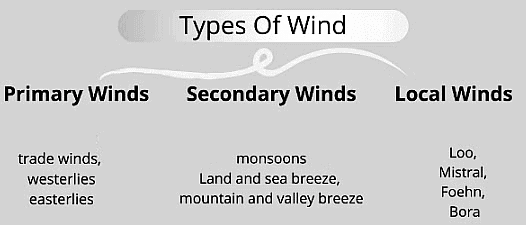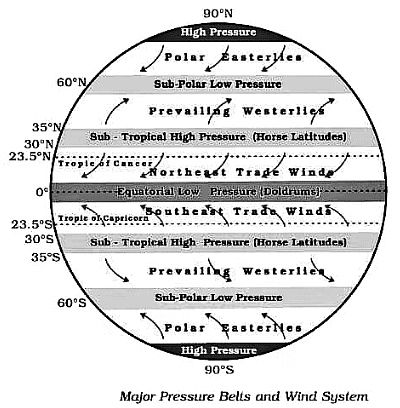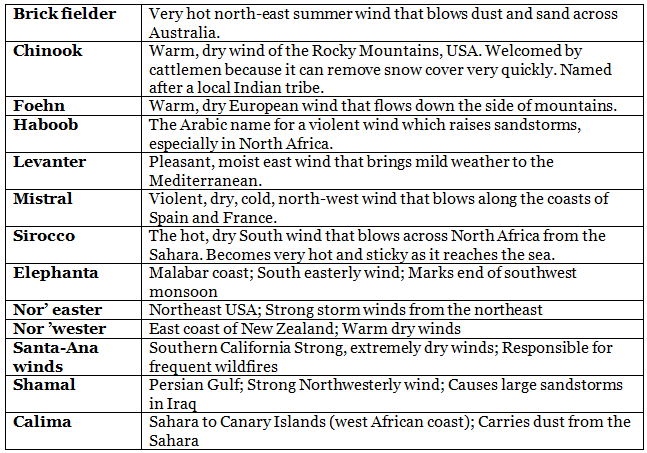UPSC Exam > UPSC Notes > Geography Optional for UPSC (Notes) > Planetary, Secondary and Local Winds
Planetary, Secondary and Local Winds | Geography Optional for UPSC (Notes) PDF Download
Introduction
Wind, in basic terms, is the lateral flow of air. This horizontal motion arises due to variations in air pressure within the Earth's atmosphere. When there is high pressure, the wind moves towards regions with lower pressure. This discussion will delve into the various categories of wind.
Types of Wind

Permanent Winds or Planetary Winds:
- Trade winds, westerlies, and easterlies are the main types.
Secondary or Periodic Winds:
- Seasonal Winds: Exhibit seasonal variations, e.g., monsoons in India.
- Periodic Winds: Include land and sea breezes, mountain, and valley breezes.
Local Winds:
- Occur only during specific periods in a limited area.
- Examples include Loo, Mistral, Foehn, and Bora.
Primary Winds or Prevailing Winds or Permanent Winds
- Planetary winds are extensive air currents that span continents and oceans.
- Among these, trade winds and westerly winds hold paramount importance for both climate and human activities.
Trade Winds
- Trade winds originate from sub-tropical high-pressure zones and move towards the equatorial low-pressure belt.
- Confined to the region between 30°N and 30°S across the Earth's surface.
- Flow as north-eastern trades in the northern hemisphere and south-eastern trades in the southern hemisphere.
- Named trade winds because of their consistent and regular direction, aiding sea merchants in navigation.
- Coriolis force and Ferrell’s law explain their deflection from the ideal north-south path.
- In the northern hemisphere, they deflect to the right, and in the southern hemisphere, to the left.
- Originating from stable, descending air in the sub-tropical high-pressure belt, trade winds become humid and warmer as they approach the equator, picking up moisture along the way.
- Convergence of trade winds from both hemispheres at the equator leads to uplift and heavy rainfall.
- Eastern parts of trade winds, associated with cool ocean currents, are drier and more stable compared to the wetter western parts of the ocean.

Westerlies
- Westerlies originate from subtropical high-pressure belts (30°-35°) and move towards sub-polar low-pressure belts (60°-65°) in both hemispheres.
- In the northern hemisphere, they blow from southwest to northeast; in the southern hemisphere, from northwest to southeast.
- Southern hemisphere westerlies are stronger and more persistent due to the vast expanse of water, while northern hemisphere westerlies are irregular due to the uneven relief of large land masses.
- Land dominance in the northern hemisphere makes westerlies complex, less effective in summer, and more vigorous in winter.
- Westerlies, passing over oceans, bring significant precipitation to western continental areas (e.g., north-west European coasts) by picking up moisture.
- Southern hemisphere westerlies gain strength and become stormy due to the dominance of oceans, associated with boisterous gales.
- Best developed between 40° and 65°S latitudes, known as Roaring Forties, Furious Fifties, and Shrieking Sixties – challenging conditions for sailors.
- The poleward boundary of westerlies fluctuates, showing seasonal and short-term variations, leading to wet spells and weather variability.
Polar easterlies
- Polar easterlies are prevailing winds characterized by dry and cold conditions.
- They blow from northeast to southwest in the Northern Hemisphere and from southeast to northwest in the Southern Hemisphere.
- Originating from polar high-pressure areas, they flow towards the sub-polar lows.
Secondary Winds or Periodic Winds
- Seasonal winds exhibit directional changes corresponding to different seasons.
- Monsoons exemplify significant alterations in the planetary wind system on a large scale.
- Periodic winds, besides monsoons, encompass phenomena like land and sea breezes, mountain and valley breezes, cyclones, anticyclones, and air masses.
Monsoons
- Monsoons were traditionally perceived as large-scale land and sea breezes, representing a colossal convectional circulation.
- Characterized by a seasonal reversal of wind direction, driven by factors such as the apparent northward movement of the sun and the intense low-pressure core in the north-west of the Indian subcontinent during summer.
- In summer, southern hemisphere trade winds are pulled northward, crossing the equator and deflecting to the right due to the Coriolis force, transforming into south-west monsoons as they approach the Asian landmass.
- Traveling over vast water expanses, these monsoons become moisture-laden, leading to heavy rainfall in India and neighboring regions upon reaching the south-western coast.
- Winter sees a reversal, with a high-pressure core forming north of the Indian subcontinent, generating divergent winds moving southward towards the equator.
- The apparent southward movement of the sun enhances this movement, resulting in north-east or winter monsoons, responsible for precipitation along the east coast of India.
- Monsoon winds affect regions including India, Pakistan, Bangladesh, Myanmar, Sri Lanka, the Arabian Sea, Bay of Bengal, southeastern Asia, northern Australia, China, and others.
- In eastern Asiatic countries like China and Japan, the winter monsoon is more potent than the summer monsoon. Further details about monsoons will be explored in the study of the Indian Climate.
Land Breeze and Sea Breeze
- Differential heat absorption and transfer by land and sea lead to distinct temperature patterns.
- Daytime sees faster land heating, creating warmer land conditions compared to the sea, causing air to rise over the land and forming a low-pressure area.
- Over the relatively cool sea, higher pressure prevails, establishing a pressure gradient from sea to land, resulting in the development of sea breeze—wind blowing from the sea to the land.
- Nighttime experiences a reversal as land loses heat rapidly, becoming cooler than the sea.
- The pressure gradient shifts from land to sea, leading to the formation of land breeze—wind blowing from the land to the sea.
Valley Breeze and Mountain Breeze
- In mountainous regions, daytime heating causes slopes to warm, leading to upslope air movement and the development of valley breeze.
- To fill the resulting gap, air from the valley blows up the valley during the day.
- Nighttime cooling of slopes results in the descent of dense air into the valley, creating mountain wind.
- On leeward sides of mountain ranges, warm katabatic winds form, with moisture condensing and precipitating while crossing mountains.
- As dry air descends the leeward slope, it warms up through adiabatic processes.
- The warmth from the dry air on the leeward slope may rapidly melt snow.
Tertiary Winds or Local Winds
- Local temperature and pressure variations give rise to local winds.
- These winds have a limited geographical extent and are restricted to the lowest tropospheric levels.
- Local winds are exemplified by various examples, which are further discussed below.
Loo
- Harmful Wind in Northern India and Pakistan: Occurs in the plains during May and June, particularly in the afternoons, as a very hot and dry westward wind.
- Temperature typically ranges from 45°C to 50°C, posing a risk of sunstroke to individuals.
Foehn or Fohn - Beneficial Wind:
- Local hot wind in the Alps, known as Foehn.
- Develops on the leeward side of a mountain range, being strong, gusty, dry, and warm (Katabatic Wind).
- Leeward descent results in dry and warm air, with temperatures ranging from 15°C to 20°C.
- Benefits include aiding animal grazing by melting snow and facilitating the ripening of grapes.
Chinook - Beneficial Wind:
- Foehn-like winds in the USA and Canada descending the west slopes of the Rockies.
- Beneficial for ranchers east of the Rockies as it prevents snow accumulation on grasslands during much of the winter.
Mistral - Harmful Wind:
- Local wind from the Alps over France towards the Mediterranean Sea, channeled through the Rhone River valley.
- Very cold, dry, and high-speed wind causing blizzards in southern France.
Sirocco - Harmful Wind:
- Mediterranean wind originating from the Sahara, reaching hurricane speeds in North Africa and Southern Europe.
- Arises from warm, dry tropical air moving northward, mixing with cooler, wetter air of maritime cyclones.
- Causes dusty dry conditions along the northern coast of Africa, storms in the Mediterranean Sea, and cool wet weather in Europe.
 |
Download the notes
Planetary, Secondary and Local Winds
|
Download as PDF |
Download as PDF
Table of Major Local Wind Systems

How is Wind Measured?
Wind speed and direction are measured using two distinct devices:
- Anemometers: Employed for measuring the speed of the wind.
- Wind Vanes: Utilized to determine the direction of the wind.
Causes of Wind
The primary cause of wind generation is the disparate heating of different regions.
Examples:
- Uneven heating between land and sea.
- Uneven heating between the equator and the poles.
The document Planetary, Secondary and Local Winds | Geography Optional for UPSC (Notes) is a part of the UPSC Course Geography Optional for UPSC (Notes).
All you need of UPSC at this link: UPSC
|
191 videos|377 docs|117 tests
|
Related Searches























